Uncovering Mars In Past History
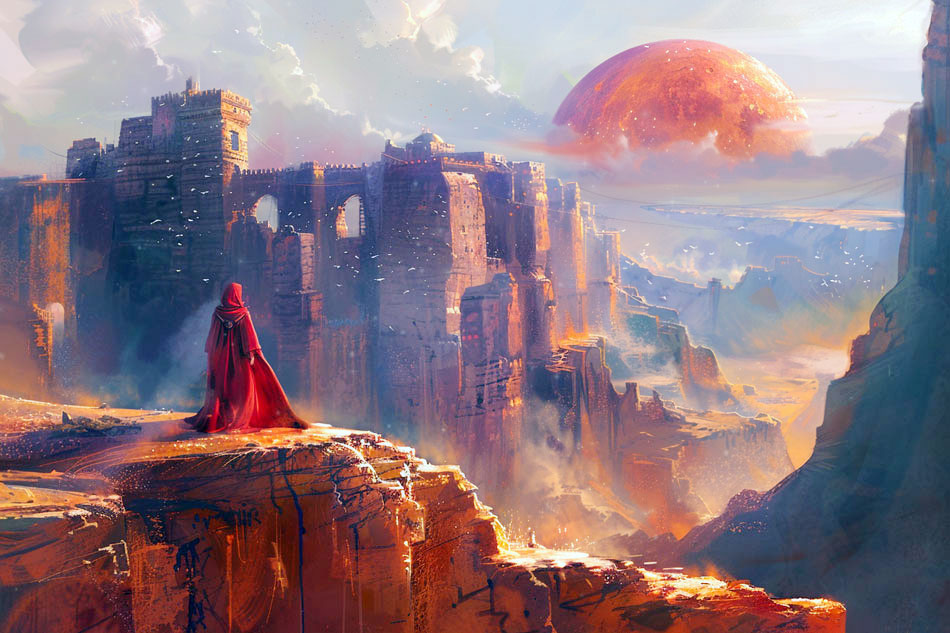 by John Brandenburg Ph.D.
by John Brandenburg Ph.D.
“Because of our sins, an unknown nation came against us, from an unknown land.” – Russian Account of the Mongol Conquest
“And he made in Jerusalem engines, invented by cunning men, to be on the towers and bulwarks, to shoot arrows and great stones…” – II Chronicles 26: 14, The Bible
In ancient Egypt the war god was named Anhur, who was also god of the sky, later subsumed into the falcon-headed god Horus, as the kingdoms of Egypt merged. Horus was called Horus the Red and was identified with the planet Mars, considered the chief of the “stars that know no rest,” as the planets were known to the Egyptians. Horus was also identified with the metal iron. Iron was called “the sky metal” in ancient Egypt and in many other ancient cultures because it was first known from meteorites, and only later smelted from terrestrial ore.
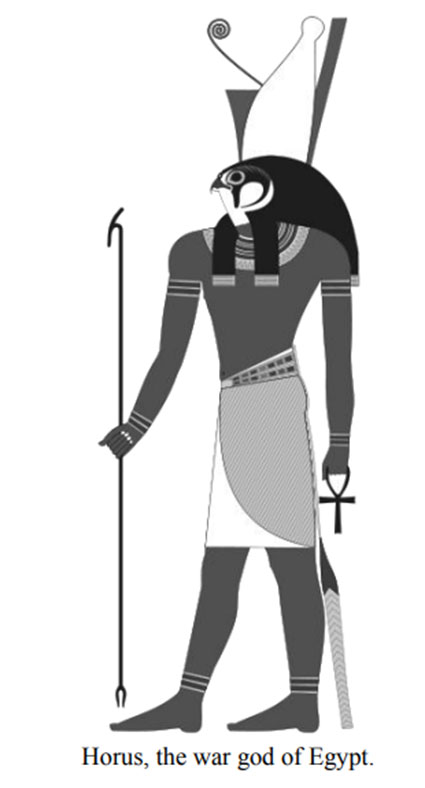 Mars has been both a bright red light in the sky and a human concept of living since ancient times. Humans are, at their worst, social predators, like the lion, the wolf, and the ant. Mars was the personification of this social predatory instinct expressed against fellow humans, who are the most dangerous creatures on the planet.
Mars has been both a bright red light in the sky and a human concept of living since ancient times. Humans are, at their worst, social predators, like the lion, the wolf, and the ant. Mars was the personification of this social predatory instinct expressed against fellow humans, who are the most dangerous creatures on the planet.
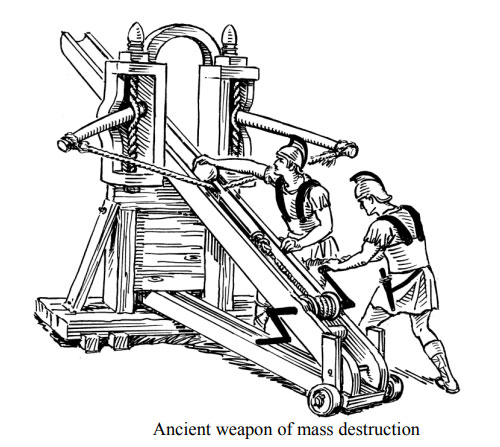 First as Nirgal in Mesopotamia, then as Ares, finally as Mars, in the Mediterranean basin, the planet Mars was the heavenly light associated with the god of war. It owed this honor to its blood red color and its close proximity in orbit to Earth, which meant that when it was in opposition, its closest point to Earth (see figure below) it would become the brightest object in the night sky. To the Romans he was represented by the male symbol, which, by some accounts, represented his shield and lance.
First as Nirgal in Mesopotamia, then as Ares, finally as Mars, in the Mediterranean basin, the planet Mars was the heavenly light associated with the god of war. It owed this honor to its blood red color and its close proximity in orbit to Earth, which meant that when it was in opposition, its closest point to Earth (see figure below) it would become the brightest object in the night sky. To the Romans he was represented by the male symbol, which, by some accounts, represented his shield and lance.
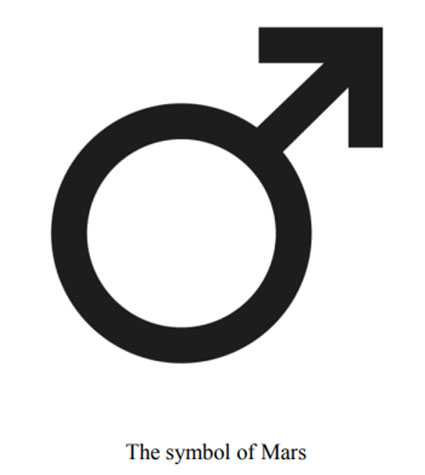
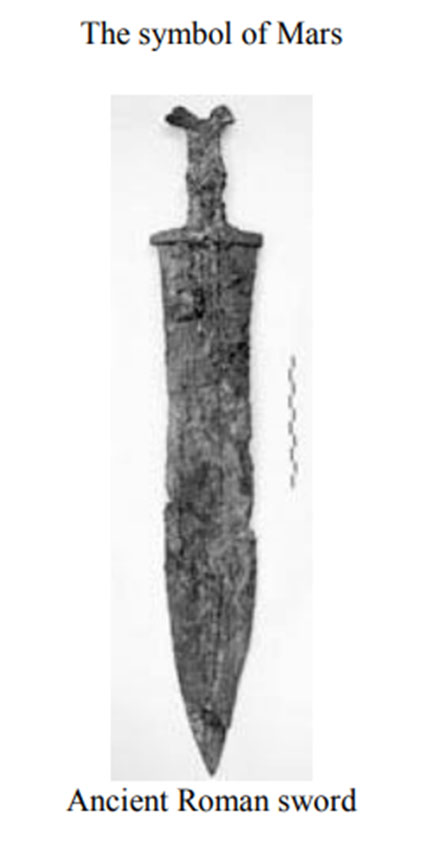
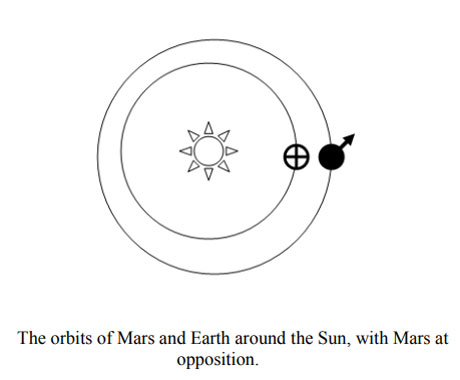
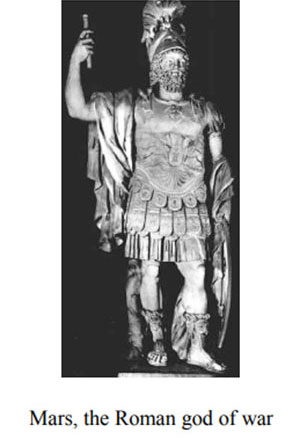 Mars is the next planet out from Earth in the solar system, followed by the asteroid belt, and then Jupiter, which is brilliant but an unremarkable yellowish-white like Venus. Venus, the next planet in, is bound, by being closer to the Sun, to be only an evening or morning star. Mars in contrast seems to roam the heavens freely and moves from one end of the night sky to the other. Every 2 years and 7 weeks Mars becomes dazzlingly bright. As Venus, the brilliant planet, evoked thoughts of love to the ancients, with its pale golden color leading to her being often pictured as a blonde, the red color of Mars evoked the sight of blood.
Mars is the next planet out from Earth in the solar system, followed by the asteroid belt, and then Jupiter, which is brilliant but an unremarkable yellowish-white like Venus. Venus, the next planet in, is bound, by being closer to the Sun, to be only an evening or morning star. Mars in contrast seems to roam the heavens freely and moves from one end of the night sky to the other. Every 2 years and 7 weeks Mars becomes dazzlingly bright. As Venus, the brilliant planet, evoked thoughts of love to the ancients, with its pale golden color leading to her being often pictured as a blonde, the red color of Mars evoked the sight of blood.
It is told that Ares (the Greek analog of Mars), the god of ultimate maleness, had a torrid affair with Aphrodite, the goddess of love. It was really a love triangle since Aphrodite was the wife of Hephaestus, at the time. He was god of volcanoes (called Vulcan by the Romans) and metal working.
To the Greeks, known for their science and philosophy, the war god Ares and the activities he represented were also very important. The Greeks were militarily very aggressive and inventive. Homer, the oldest literary figure of the Greeks, is not famous for a tale of peace, but for the story of Helen of Troy. The Fall of Troy was accomplished through the stratagem of the Trojan horse, and this tale may represent an embellished report of the use of a siege tower against a walled city
The tale of the Odyssey celebrates the great accomplishments of the Greeks as the first great mariners of the Mediterranean. In that tale Odysseus, who was the favorite of Athena, the goddess of wisdom, journeys by sea on a great voyage of peril as well as discovery of strange new lands. His unfortunate journey, and the general misfortune of the Greeks returning from Troy, was due to the wrath of Athena, for the Greeks, in their destruction of Troy, had violated her temple by seizing Cassandra the prophetess there after she had sought sanctuary.
War, unlike nature, presents humans with a set of problems that are constantly and rapidly evolving. Since ancient times, war, or the threat of war has been a constant driver of technology and sciences. It has also been a source of much of humanity’s misery, a fact not lost on the Greeks, who pictured Ares as a rascal and trouble maker.
To the Romans, who conquered the Greeks and took their mythology along with everything else of value back to Rome, Ares merged with an old Roman deity Mars supplanting that god’s previous role as a god of agriculture. This transformation mirrored the elevated role of war in Roman society, as it transformed itself from a republican city-state mostly interested in farming into a sprawling empire guarded by a massive military. To the Romans, Mars represented the epitome of manhood, courage, boldness, cunning, discipline. The love triangle of Ares, Aphrodite, and Hephaestus became Mars, Venus, and Vulcan, and went from being a tale of scandal on Olympus to a cautionary tale for men who considered avoiding military service. The warrior gets the girl, and the honest workman is left with a new set of horns. To serve Mars was to become a human predator, and like all predators he cultivated a cunning and aggressive intelligence.
When war was declared in ancient Rome, a frequent occurrence, the doors of the temple of Mars were thrown open. The lance of Mars was then brought out before the crowds in a ritual display. In the adulation of the crowd was the decision of war validated.
Mars was a god who constantly inspired the search for new technologies. The sword, which we regard as the traditional symbol of things military, was in fact viewed as a remarkable innovation and sign of capable metal-working technology by the ancients. It was literally a “long knife” in the terminology of the Native Americans of the Plains and took lots of metal, either bronze or steel, and the ability to shape it into large pieces. This required a skill level and capability to obtain amounts of strong metal far beyond that required for hunting, fishing or protecting flocks from predators. For a wolf or lion, a big spearhead or arrow head, or even a sling stone, was all that was required to kill or drive them off. However, to fight the people in the next river valley, you needed swords. Woe unto the people whose skill at the creation of swords was inferior to its neighbors. As agriculture made the supporting of large urban populations possible, the walled city became the norm and to serve the god Mars properly one had to learn to defeat them. This led to the design and construction of siege engines, the first weapons of mass destruction to be developed.
To throw stones from a catapult against city walls effectively one needed to be able to predict ranges. To predict ranges for rocks one needed to know their mass. The Greeks discovered that a rock made round like the Sun or Moon had a mass that was proportional to the cube of its radius, and hence it has been found that the Greeks solved this problem by a graphic method for their catapult operators. The graph gave the mass of the spherical rock based on its radius. Thus, one of the first applications of Greek mathematics and geometry was in war.
The ability to build a strong wall to guard your city was a highly desirable skill in ancient times. The best walls were of large tough stones shaped into bricks of the same size and shape. Smaller or larger bricks were weak links in the chain of defense.
Such were the walls of Troy which the Greeks could not breach in ten years of war. Make your walls of weak stone, and come the time “when kings go forth to war,” your neighbors will come with battering rams and break down your walls. So the school of Mars offered degrees in stone masonry in ancient times as well as metallurgy.
To make a good wall the number of equal-sized bricks of good stone required mathematics. In particular this required that the diagonal measure of each section of wall be a whole number of bricks as well as the height and width. The Egyptians knew this when they constructed the pyramids, for the length of the faces of pyramids is a factor of five to three times the length of half the pyramid base, and likewise the face length is a ratio of five to four to its height. The half length of the base squared and height squared are the length of the face squared in a 3:4:5 ratio, or 9:16:25 when squared.
To the base of this pyramid came the philosopher Pythagoras and studying from it he generalized that the diagonal of any rectangle squared was the sum of the sides squared. This enabled stonemasons to build stronger walls for cities because they could get the number of bricks right. Pythagoras had a more than academic interest in helping the Egyptians build better walls at that time. The Persians invaded Egypt and conquered it while he was there and he was imprisoned. When released, he returned to Greece with tales of the cruelty of the Persians, and thus prepared Greece for its own war with the Persians, a generation later.
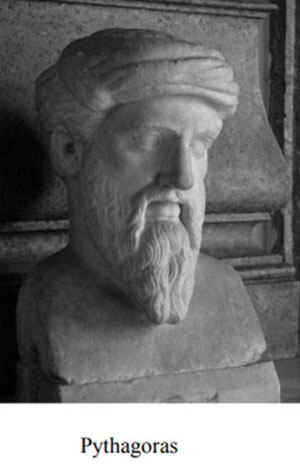

Later the Vikings developed their own written record of their religion, and Tyr, the god of war, was among their pantheon. He was a noble and fearless character, who was the only god of Asgard who could deal with the great wolf Fennir. When the wolf became too dangerous to run free, Tyr gave his right hand as pledge to the great wolf, placing it in the wolf’s mouth, while it was chained by trickery. When the wolf realized it was now chained, Tyr’s hand was his sacrifice. In the last battle between the gods and the forces of evil at Ragnarok, Tyr dies valiantly while slaying the great hell-hound Garm.
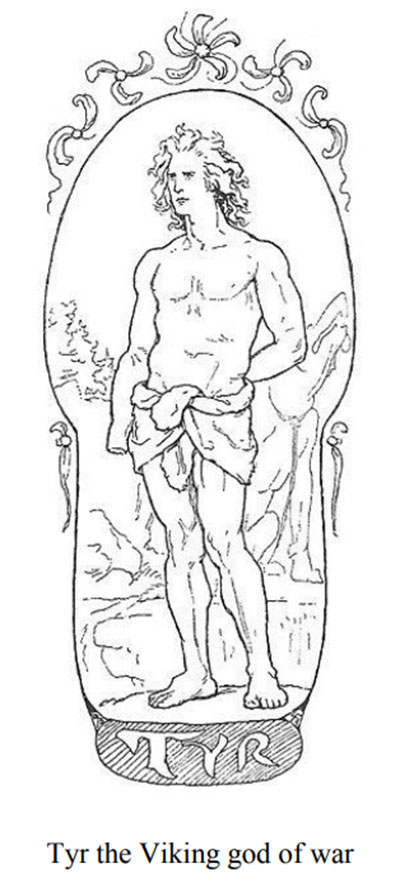 Tyr was notable also as the god of the All-thing, the first parliament. It was in the All-thing that all things could be discussed freely and votes taken. This form of government spread from the Vikings to ancient Britain and became the basis for modern democracy. Tyr, under the name Tue, is honored now in the second day of the week, Tuesday, which, in the Latin tradition, is called Mars. His symbol dispensed with the shield and got straight to the point.
Tyr was notable also as the god of the All-thing, the first parliament. It was in the All-thing that all things could be discussed freely and votes taken. This form of government spread from the Vikings to ancient Britain and became the basis for modern democracy. Tyr, under the name Tue, is honored now in the second day of the week, Tuesday, which, in the Latin tradition, is called Mars. His symbol dispensed with the shield and got straight to the point.
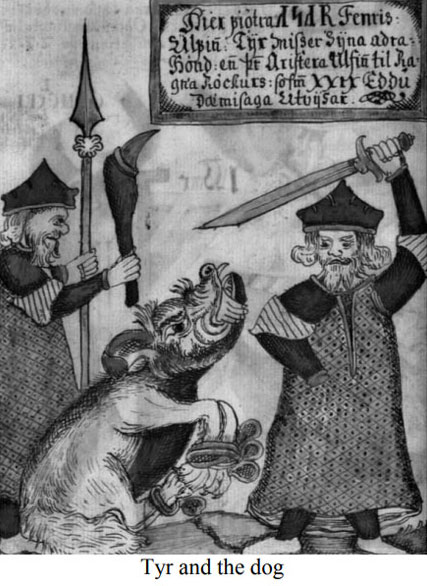
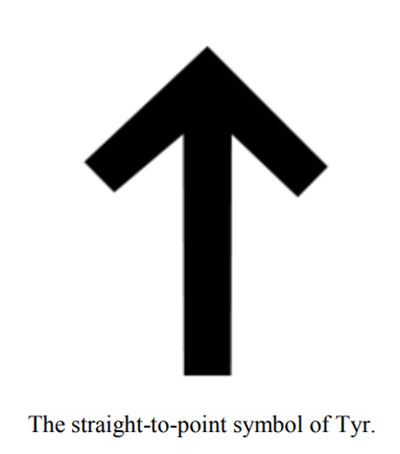
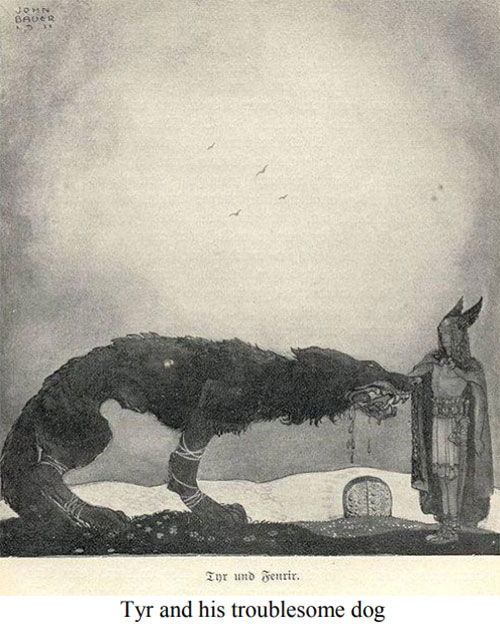
The school of Mars did not end in ancient times. Even if Mars ceased to represent a god and instead, with the advent of a Christian Europe, became just a planet, a moving light among the fixed stars, it lost none of its old meaning. Mars’s spell lived on in the astrological tables, especially in the astrologers’ tables that gave advice to Kings.
The periodic oppositions of the planet Mars, 2 years and 7 weeks apart when it is closest to Earth and thus dominates the night sky, became occasions for the time “that Kings go forth to war,” entailing the launching of wars of aggression for kings and nations who felt a need to invade their neighbors periodically. They would ask themselves, “if the sky itself appears to be provoking blood lust with this big red star, who are we puny humans to argue with it?” Astrologers, all reading from the same sky, would advise weaker kings to be on their guard at such times and look to their defenses. Thus, even through the Middle Ages and into the Renaissance, a cycle of human activity appeared, based on the opposition of Mars, which made kingdoms mobilize and adrenaline, and testosterone, levels rise periodically. This led to the careful study of Mars’s movement in the sky, for whoever could predict it best, would get the king’s attention and funding. It was in the midst of this pulse beat that the scientific revolution occurred.
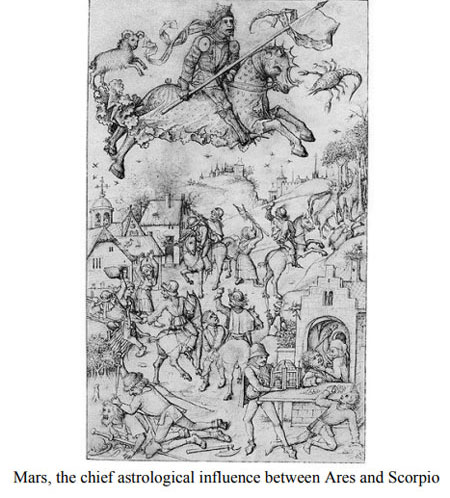
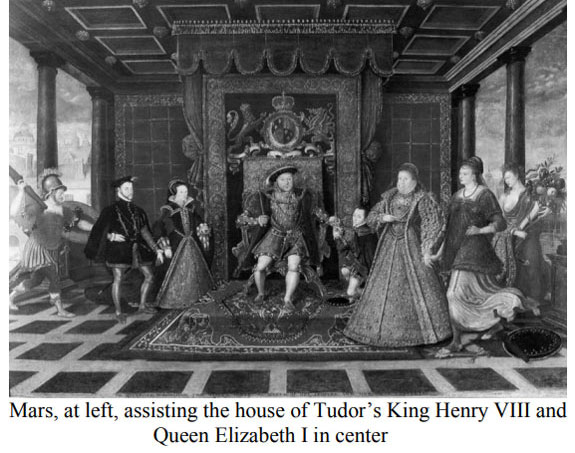
It can be said that the scientific revolution began with the publication in 1570 of the book On the Orbital Revolutions of the Heavens by Copernicus, who was a Pole. Poland stood at the outer frontier of Catholic Europe, a flat land with no natural barriers to movement sitting on the edge of the vast plains of Asia. The broad plains, or steppes, of Asia stretch from the borders of Poland to the great Wall of China. Poland was a nation that had taken a hard course of study in the school of Mars.
In 1241 Poland had experienced an invasion from outer space. The Mongols, an unknown tribe from near the border of China, suddenly appeared and destroyed Kiev in the Ukraine, and slaughtered all its inhabitants. The Mongols then charged into Poland. Using an army of horse-mounted archers and employing gunpowder to create confusion, the Mongols crushed every army the Poles could send against them and destroyed several major cities in the land. Finally they destroyed an allied army of Germans and Poles at Legnica (also known as the Battle of Liegnitz) before charging down into Hungary and ravaging that land as well. Then, as quickly as they had appeared, the Mongol armies disappeared back into the steppes. All of Europe reacted in terror and fear at the reports of what had happened in Poland and Hungary, and armed themselves and waited. It was a good time to be a student of Mars. Fortunately for Europe the expected major Mongol invasion did not come. The Mongols raided several times but the Poles and Hungarians, now being better equipped and forewarned, put up furious and costly resistance. Many speculate, however, that the armies of Europe would not have been able to stop a determined and forceful Mongol invasion. Europe was indeed fortunate. The Mongols conquered China and destroyed Baghdad in the same time period, creating pyramids of human heads everywhere they went. It is believed that their reign of terror was one of the worst episodes of mass murder in history, only exceeded by those in modern times.
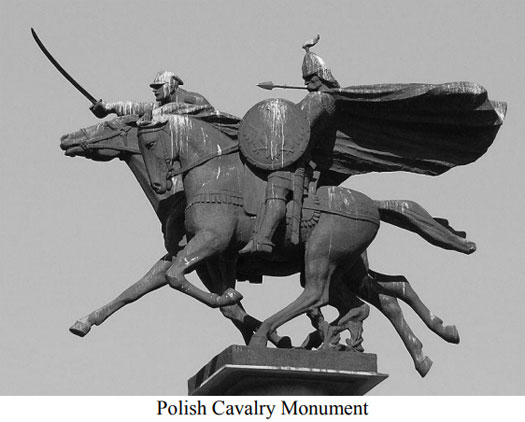
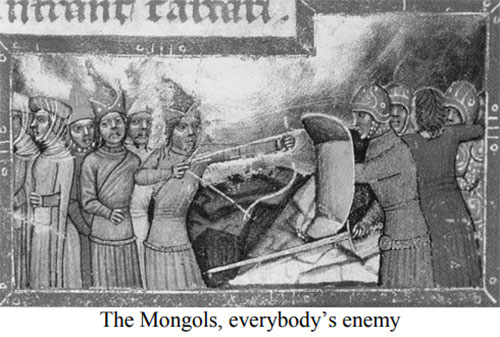
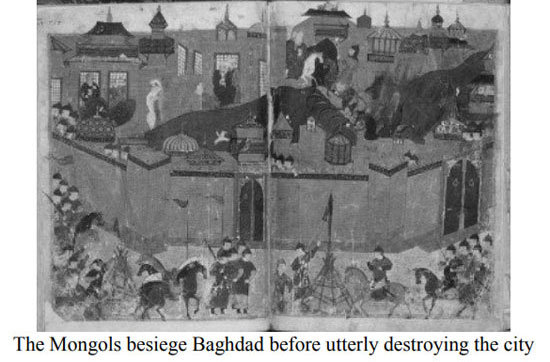
Therefore, Poland was a flat land stuck in the rest of the Middle Ages between the warlike and aggressive Germans on the west and the raiding Mongols on the east, who continued to raid. The Poles, playing off one side against the other for centuries finally emerged as a powerful land empire, with a cavalry force of legendary skill and courage. The Polish cavalry learned to fight both the Mongols and Germans effectively and thus Poland’s peace was preserved. It can be said that the Poles, at length, achieved the Dean’s list in the school of Mars. This allowed Poland to flourish and create great centers of learning.
Copernicus was a good Catholic and belonged to an institution then immersing itself in ancient Greek and Roman learning. Being a Pole, Copernicus stood at the frontier of European thought, and could gaze into the vast darkness of the steppes. Perhaps this sense of confronting a constant unknown made him bolder than other Europeans of the times. He revived a concept of the ancient Greek philosopher Aristarchus, who said that Earth, together with the other planets, moved in circles around the Sun, and showed that this made the prediction of the movements of the planets simpler mathematically. His system was, in a word, “elegant” compared to the then accepted system of putting Earth at the center of the universe with the planets, Sun, and Earth’s moon moving in complex “epicycles,” circles within circles, around it.
This heliocentric view looked nice on paper. It held to the “minimum of entities” rule. However, it had the unfortunate problem of demoting humanity from being the ruler of the center of the universe, to being rulers of just one of the planets. This meant that the Catholic Church, Copernicus’s employer, was also demoted, because it took care of humanity’s spiritual well being. The Church, at that time, prided itself on being able to answer all the “Big Questions.” Copernicus realized that his new model of the universe might raise a host of new, and difficult to answer, big questions, and that the Catholic Church might not be pleased. Copernicus handled this problem with characteristic Polish genius; he made sure he was dead before the book was published.
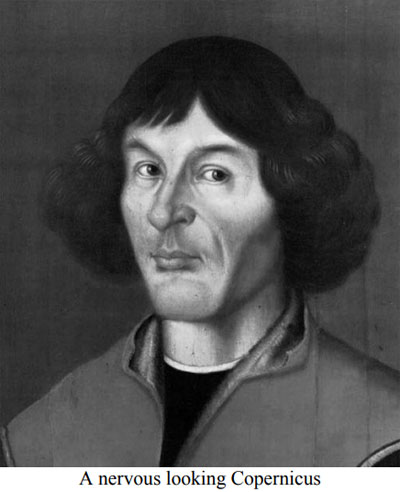
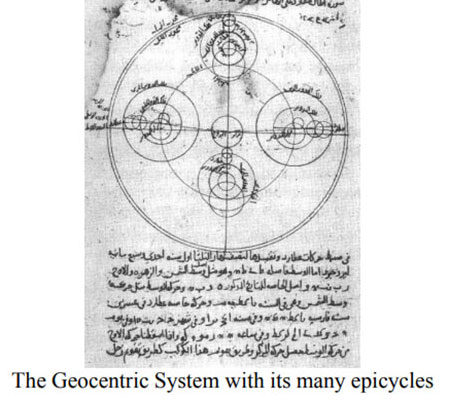
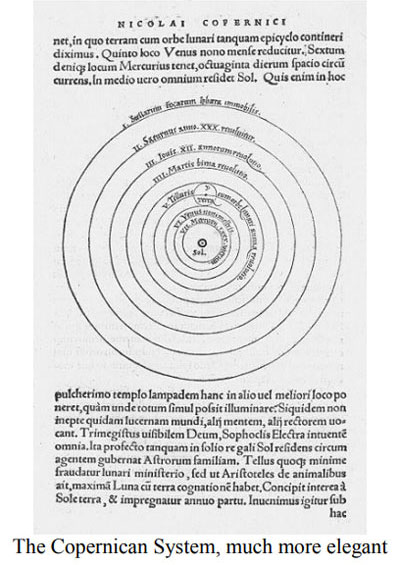
The Poles stopped the Mongols from invading Europe further, but they were helped in this by events far to the east that had been recounted in Europe by Marco Polo. Polo had reported that the Mongols, at the height of their power after conquering China, had tried to take the farthest land of the Far East, Japan, and failed disastrously, not once but twice. This pair of defeats badly depleted the Mongol armies of men and ambition. These disasters had been due partly to fierce storms that wrecked the invasion fleets but were also due to the valor and skill of the Samurai, who held the Mongols on the beaches until the miraculous storms arrived.
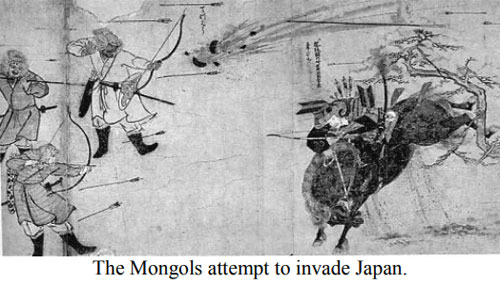
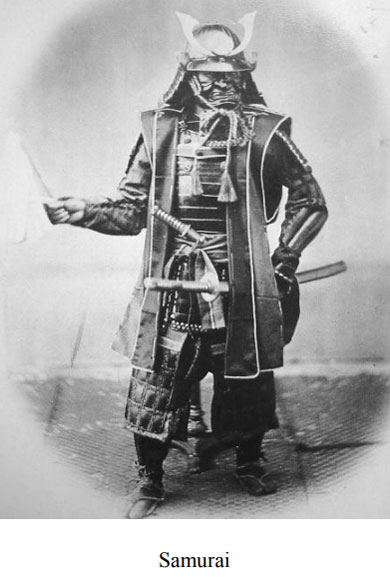
The Samurai were avid pupils in the school of Mars, and worshiped the god of the warriors Hachiman, who was gentrified by Buddhism as the protector of Japan.
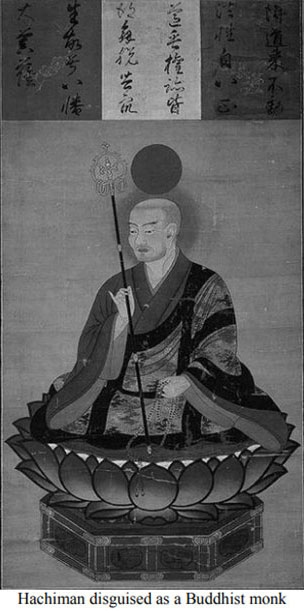 Back in Europe, Giordano Bruno, a Gnostic philosopher of the time, became quite excited about the Copernican concept and carried it further. Bruno went around Europe saying that not only did the Earth and other planets orbit the Sun, but that the stars were in fact other suns viewed far away, with planets orbiting them, and with people like us living on those planets. This meant that not only was humanity merely ruler of a planet, but this planet might not be a particularly important planet in the cosmos. He was promptly arrested by the Church and burned at the stake in 1600 when he would not recant this idea. The Church was uncomfortable with the idea of humanity ruling just a speck of stardust, and being one of myriad other peoples among the stars. Such ideas would prompt questions from the people and the Church did not like questions, especially when they could not answer them.
Back in Europe, Giordano Bruno, a Gnostic philosopher of the time, became quite excited about the Copernican concept and carried it further. Bruno went around Europe saying that not only did the Earth and other planets orbit the Sun, but that the stars were in fact other suns viewed far away, with planets orbiting them, and with people like us living on those planets. This meant that not only was humanity merely ruler of a planet, but this planet might not be a particularly important planet in the cosmos. He was promptly arrested by the Church and burned at the stake in 1600 when he would not recant this idea. The Church was uncomfortable with the idea of humanity ruling just a speck of stardust, and being one of myriad other peoples among the stars. Such ideas would prompt questions from the people and the Church did not like questions, especially when they could not answer them.
Galileo, in Italy, was a man of vast genius who created a fancy new telescope. He was professor at the university and wanted to gain favorable attention of the head of his department. He had been analyzing how things moved, and developed the idea of Galilean motion and gravity acceleration. He was a showman who reportedly rolled two cannon balls of different weights off the leaning tower of Pisa to prove that they both fell at the same rate and would hit the ground at the same time. He used iron cannon balls because they were a new high tech invention and flew better through the air than the stone cannon balls used previously. He then used this new science and math for describing how cannon balls moved to develop excellent elevation versus range tables for military artillery. These tables were so good they were standard on the Earth until World War One.
Improved artillery tables were regarded with favor by the Catholic Church. The Church was studying in the school of Mars vigorously in those days. It was concerned with protecting Christian Europe from conquest by the Muslim Turks and conquering the land now held by the Protestants in Germany. However, Galileo soon attracted attention of a less favorable kind from the Church. He pointed his telescope at Jupiter and saw a set of moons like pearls on a string. The church had basically ignored Copernicus’s ideas, hoping they would go away. The church teaching remained that the Sun, Moon, and visible planets represented the seven deadly sins and seven heavenly virtues. The gaggle of moons that Galileo saw orbiting Jupiter in a miniature Copernican system suggested, at the very least, that many new sins might await discovery. This would prompt questions. Galileo was therefore promptly arrested by the church in 1610 after his report of strange new objects in the sky. He was charged with “vehement suspicion of heresy.” Threatened with torture, he wisely recanted his sightings of strange lights in the sky and was released by the church authorities with the warning: “in the future, Doctor, leave the big questions to us.”
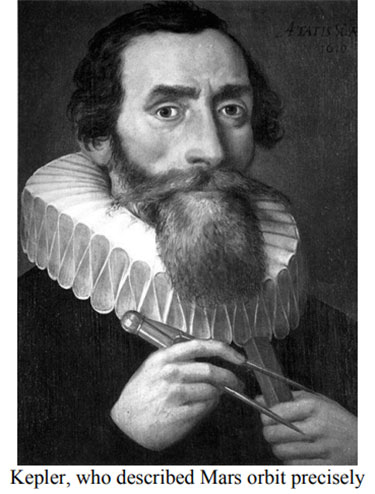
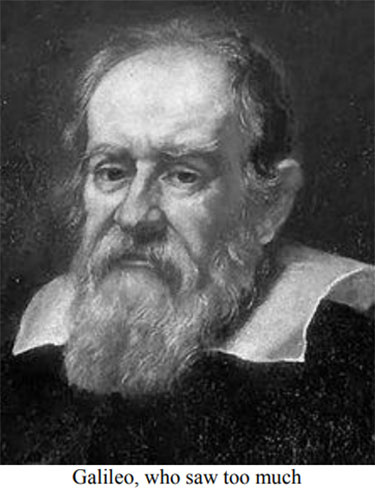
In a contemporary set of events, Tyco Brahe, court astrologer to the King of Denmark, told his assistant Johannes Kepler to “study Mars” if he wanted to understand the orbits of the planets. For, noted Brahe, Mars had the most unusual of any planetary orbit, being difficult to predict even with the theory of Copernicus, which used circular orbits for the planets. In an epic accomplishment of the human intellect, Kepler was able to explain the orbits of the planets as ellipses in 1609, using mathematics originally worked out by the ancient Greeks, and now rediscovered as part of the Renaissance. In one great leap he not only described the orbits of the planets, but showed that the learning of the ancients was required to understand them. He thus validated both the progressive and traditional elements of the Renaissance. In 1619, he followed his earlier achievements with the discovery that the period of the orbits of the planets was proportional to the radius of their orbit to the 3/2 power.
The world had become larger then, to the Europeans, with the discovery of the New World by Columbus in 1492. This expedition was backed by the Spanish who then led the European invasion of the New World. It was the collision of that part of the human race that had long ago moved west from Africa until it had run into the Atlantic Ocean and been held there, with the other end of the human race that had moved from Africa and then east into Asia and from there to North America, until it stood on the other side of the Atlantic from Europe. Two portions of the human race that had had no contact for thousands of years were now at a collision point. Cortez led an expedition to Mexico from the Spanish base in Cuba. He was a man who, upon landing in an exotic land with an alien civilization, attacked an empire of millions with 800 men. He had more than sheer bravado and machismo on his side. For one thing, Cortez knew he had the best infantry in Europe.
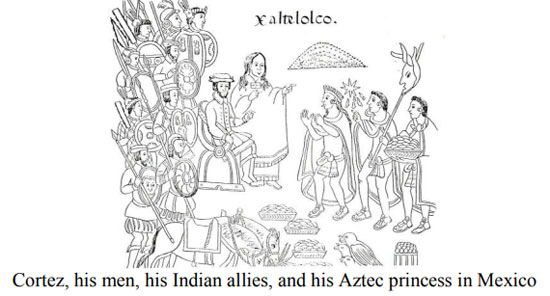 The Spanish man of war, the guerro, was the product of the school of Mars on the Iberian Peninsula. Almost a millennium of war during the Christian “reconquista”of Spain from the Muslim Moors had transformed Spain into a society dominated by war and the men who waged it. Daring, strength, cunning, religious zeal, and aggressive opportunism were qualities to be cultivated and admired on the battlefield and off. Hernando Cortez possessed all of these quantities in abundance. He had landed in Mexico, taken a look at the coastal tribes, assessed their inferior technology, bested them in battle, and been given a lovely slave girl as a gift. She, as it turned out, was a princess of the Aztecs, the real rulers of the land, who had been sold into slavery to their vassals, the coastal tribes. She became Cortez’s lover, learned Spanish quickly, and informed him of the whole political situation in the land, and of the legend of Quetzalcoatl, a god Cortez resembled. He instantly digested all of this and saw how to take the whole place. For her it was payback time, for him, in a stroke of wild genius, it was a golden opportunity. So in 1516, a quarter century after discovering the New World, Spain conquered territories and populations larger than themselves, and became the richest and most powerful nation in Europe.
The Spanish man of war, the guerro, was the product of the school of Mars on the Iberian Peninsula. Almost a millennium of war during the Christian “reconquista”of Spain from the Muslim Moors had transformed Spain into a society dominated by war and the men who waged it. Daring, strength, cunning, religious zeal, and aggressive opportunism were qualities to be cultivated and admired on the battlefield and off. Hernando Cortez possessed all of these quantities in abundance. He had landed in Mexico, taken a look at the coastal tribes, assessed their inferior technology, bested them in battle, and been given a lovely slave girl as a gift. She, as it turned out, was a princess of the Aztecs, the real rulers of the land, who had been sold into slavery to their vassals, the coastal tribes. She became Cortez’s lover, learned Spanish quickly, and informed him of the whole political situation in the land, and of the legend of Quetzalcoatl, a god Cortez resembled. He instantly digested all of this and saw how to take the whole place. For her it was payback time, for him, in a stroke of wild genius, it was a golden opportunity. So in 1516, a quarter century after discovering the New World, Spain conquered territories and populations larger than themselves, and became the richest and most powerful nation in Europe.
That a band of such men of war, led by one such as Cortez, would form the spear point of collision between the old world and the new was not an accident of history. Fortune favors the brave, and also leads them to journey far. Mars teaches us that anyone who comes here to Earth across the starry gulf may have gone to the same school as Cortez.
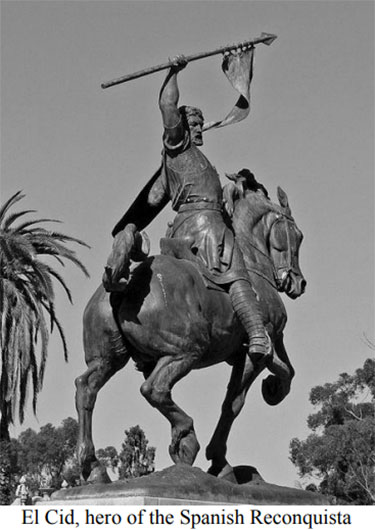
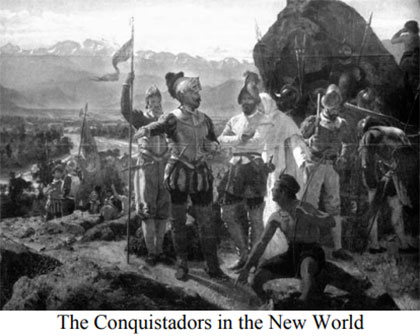
The Spanish used Mexico as their springboard for invading the Pacific basin, and invaded and conquered the Philippines in 1565. Enriched and supplied from their bases in the Americas, the Spanish seemed all powerful. They turned north from the Philippines, eyeing the rich islands of Japan, but were stopped there utterly. The Samurai waited for the Conquistadors on the beach. The Samurai had what the Aztecs of Mexico lacked, steel, horses, and something else. Thanks to some shipwrecked Portuguese, several years before, the Samurai possessed gunpowder and firearms when the Spanish arrived. So the Spanish trail of conquest ended abruptly. This collision with the Spanish, particularly their attempt to conquer Japan through Catholicism, having failed to do so by force of arms, caused the Japan to retreat into seclusion until the 1800s.
It remained for Newton to finish the great work of understanding the heavens. Once again it was the orbit of Mars, with its markedly elliptical shape, rather than a nearly perfect circle like Earth’s orbit, that was the challenge. In a circle, centrifugal force and gravity balance and are constant. The algebra of the Arabs could suffice to solve this. However, in an ellipse, the forces vary constantly. What was needed was a form of mathematics that could solve for things that varied constantly. With a quantum leap in human understanding, Newton published his epic tome: Principia Mathematica, in 1687, where he invented both the laws of gravitation and the laws of motion, but also invented calculus to describe the motions that resulted. In one step, he validated the works of Kepler and Galileo. To the intellectuals of the time, the cosmos was transformed by Newton from an impenetrable mystery to a grand and beautiful mechanism.
In this entire journey from Copernicus to Kepler and finally to Newton, the orbit of the planet Mars was the chief problem to be understood. Thus it can be said that the planet Mars was not only the inspirer of cutting-edge technology, literally, from ancient times, but acted as midwife to the scientific revolution.
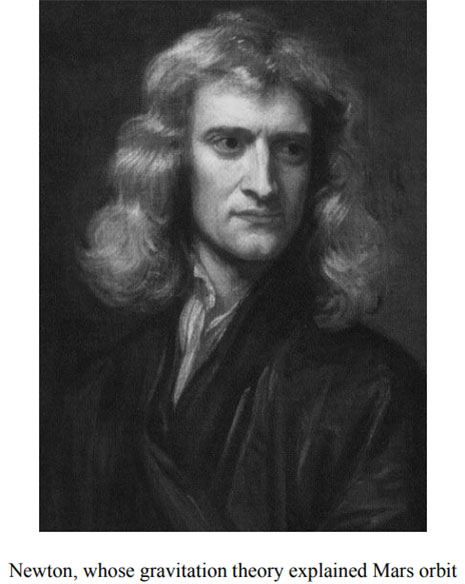
Excerpt from Life And Death On Mars
Part II coming soon.
Posted in Other Topics, The Truth About Mars, True History of Manwith no comments yet.



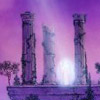

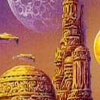
Leave a Reply